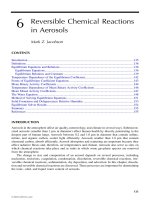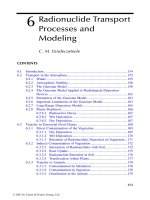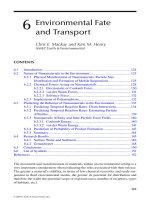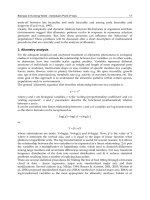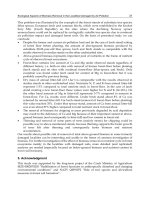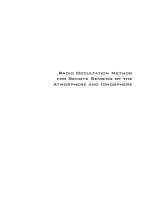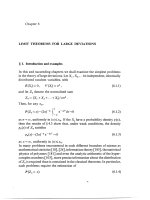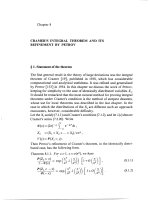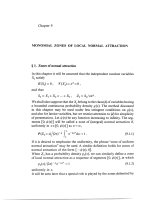Radio Propagation and Remote Sensing of the Environment - Chapter 6 pps
Bạn đang xem bản rút gọn của tài liệu. Xem và tải ngay bản đầy đủ của tài liệu tại đây (979.4 KB, 54 trang )
© 2005 by CRC Press
157
6
Wave Scattering by
Rough Surfaces
6.1 STATISTICAL CHARACTERISTICS OF A SURFACE
Many natural surfaces, such as the soil surface or water surface of the ocean, can
be regarded as smooth only in certain circumstances. In general, these surfaces
should be considered to be rough, and their interaction with radiowaves should be
seen as a scattering process. Whether or not we assume that the surface is rough
generally depends on the problem formulation and, particularly, on the ratio of the
roughness scales and the wavelength. The nature of the roughness varies depending
on the type of surface. Sea surface roughness is a result of the interaction of the
wind with the water surface. This interaction has a nonlinear character. A great
number of waves with different frequencies and wave numbers are generated as a
result, and their mixture leads to oscillations of the sea surface height according to
the stochastic function of coordinate and time. However, the velocity of the sea
surface movement is small compared to the velocity of light, so time dependence
cannot be taken into account in the first approximation. Soil roughness can form as
a result of wind erosion, urban activity, and other causes. The soil roughness is also
a random function of coordinates. Again, a dependence on time is not considered
in the beginning and we are dealing generally with wave scattering by random
surfaces. The specific surface will be described by a random function of the elevation
The average value so it is assumed that the average
surface is given by the plane The function is supposed to be statistically
homogeneous. It simplifies the problem substantially, as the statistical homogeneity
of the real natural rough surfaces take place in the restricted cases. The correlation
function:
(6.1)
depends, in this case, on the coordinate difference of the points involved. In many
cases, the surface may be assumed to be statistically isotropic. Then, the correlation
function depends only on the module (i.e., on the distance between the
points of correlation). The correlation function has significant value within the
correlation radius which is often defined by the relation:
(6.2)
ζ(), { }.sswhere x,y=
ζ() ,s = 0
z0.=
ζ()s
ˆ
K
ζ
ζζ
′
−
′′
()
=
′
()
′′
()
ss s s
′
−
′′
ss
ld d
2
2
2
2
0
12
=
()
=
∫∫
∞
ζ
π
ζ
ζζ
KKss (s)s s.
TF1710_book.fm Page 157 Thursday, September 30, 2004 1:43 PM
© 2005 by CRC Press
158
Radio Propagation and Remote Sensing of the Environment
It is necessary to represent the correlation scales along the main axis of the anisotropy
ellipse in the case of statistical anisotropy.
If we suppose that roughness occupies the bounded surface
Σ
for whose measure
is much larger than the radius of correlation, then the following Fourier expansion
is correct:
. (6.3)
The spatial spectrum:
(6.4)
is a random function with zero mean. Its correlation function is written as:
By introducing the “gravity center” coordinate and the difference
, the last integral can be written in the form:
Let us represent the elevation fluctuation spectrum of the examined surface as:
(6.5)
according to the Wiener–Chintchin theorem. The integral in this expression can be
spread over infinite limits because the size of the chosen surface was set much larger
than the correlation scale. Thus,
(6.6)
It follows from here, in particular, that at :
ζζ() ()sq=
⋅
∫
ed
iqs
q
2
ζ
π
ζ() ()qs=
−⋅
∫
1
4
2
2
ed
iqs
s
Σ
ζζ
π
ζ
′
()
′′
()
=
′
−
′′
()
∗
−
′
⋅
′
−
∫∫
qq ss
qs
1
16
2
ˆ
K
Σ
e
i
′′ ′
⋅
′′
()
′′′
qs
ssdd
22
.
′
+
′′
=ss S2
′
−
′′
=ss s
ζζ
π
ζ
′
()
′′
()
= −
′
+
′′
⋅
∗
s
1
16
2
2
ˆ
()expKs i
−
′
−
′′
()
⋅
∫∫
de d
i
22
sS
qq S
.
ΣΣ
Kq K
ζζ
π
()
ˆ
() .=
−⋅
∫
1
4
2
2
ss
qs
ed
i
ζζ
π
ζ
′
()
′′
()
=
′
+
′′
−
′
−
′′
1
4
2
2
K e
i
(()
⋅
∫
S
Sd
2
.
Σ
′
=
′′
=qq q
TF1710_book.fm Page 158 Thursday, September 30, 2004 1:43 PM
© 2005 by CRC Press
Wave Scattering by Rough Surfaces
159
(6.7)
where we have simplified the expression by not distinguishing between the value of
the surface and its square. If then the integral in Equation (6.6) can be also
taken to infinite limits by maintaining the condition . As a result,
(6.8)
The correlation function of the scalar product is:
(6.9)
In particular,
(6.10)
Let us now turn to the case of a statistically isotropic surface. We can assume
that the main area of integration is situated in the interval therefore,
the following estimation is valid:
On the other hand, it is easy to determine from Equation (6.2) that
As a result, we have:
(6.11)
Further, we will encounter the correlation vector :
(6.12)
ζ
π
ζ
()
()
,q
Kq
2
2
4
=
Σ
′
≠
′′
qq,
′
−
′′
>>qq Σ 1
ζζ δ
ζ
′
()
′′
()
=
′
+
′′
′
−
′′
()
qqK
2
.
∇
′
()
⋅∇ = −∇ ==
′
⋅
ζζ
ζζ
sqss
qs
() () () ,sKsKq
22
q
2
ed
i
−−
′′
∫
s .
∇
()
=
()
∫
ζ
ζ
2
2
q
2
K qqd .
0 ≤≤q2π l;
∇
()
≅ =
∫
ζπ
π
ζ
π
ζ
2
0
2
3
4
20
8
0
KK() ().qq
3
d
l
l
l
22 2
40=
()
〈〉πζ
ζ
K .
∇
()
≅ζπ
ζ
2
3
2
2
2
l
.
=
()
⋅
′
−
′′
∫
ied
i
qq q
qs s
K
ζ
()
.
2
TF1710_book.fm Page 159 Thursday, September 30, 2004 1:43 PM
© 2005 by CRC Press
160
Radio Propagation and Remote Sensing of the Environment
And, finally, we can calculate the value:
The last expression is easily transformed to the form:
(6.13)
The previous discussion was concerned with smooth and differentiable surfaces.
It is often convenient to eliminate the requirement of differentiability when describ-
ing natural surfaces (sea, soil, etc.). To illustrate, we will analyze the structure
function of properties of the surface:
(6.14)
assuming statistical isotropy of the surface. It is usual to suppose in the case of a
smooth surface that the first derivative of the correlation function at zero is equal
to zero ( ). Then, the expansion:
(6.15)
for the structure function is valid close to zero. Such a surface has slopes, which
means that the angle is equal to zero and the dispersion (the mean-square slope) is
defined as:
. (6.16)
The differentiability of the surface is understood in such sense.
Many natural surfaces have a fractal character.
78
Their structure function satisfies
the equation:
(6.17)
The index
α
is connected with fractal dimension
β
(Hausdorff–Besicovitch dimen-
sion) by the relation:
. (6.18)
ζζ
π
ζζ
π
ζ
() ( ) ()
ˆ
sq s K
=
′
()
′
≅
−⋅
′
1
4
1
4
2
2
2
ss s
qs
ed
i
−−
′
()
′
−⋅
′
∫∫
ss
qs
ed
i 2
.
Σ
ζζ
ζ
() ( ) () .sq Kq
=
−⋅
e
iqs
D
ζ
ζζ
′
−
′′
()
=
′
()
−
′′
()
ss s s
2
ˆ
()
′
=K
ζ
00
D()
ˆ
()sK s
2
=
′′
ζ
0
∇
()
= −∇ = −
′′
=
→
ζ
ζζ
2
2
020
1
2
ˆ
()
ˆ
() lim
)
KK
(s
s
0
2
s
D
DB(s s) =
α
αβ= −
()
22
TF1710_book.fm Page 160 Thursday, September 30, 2004 1:43 PM
© 2005 by CRC Press
Wave Scattering by Rough Surfaces
161
The value obtained lies within the range , which leads to an index interval
of in Equation (6.17). It would not be correct, in this case, to address the
differentiability of the surface. The maximum value of
α
leads to Equation (6.15),
which is typical for smooth surfaces. The value , which follows from
the theory of Brownian motion, corresponds to the Brownian fractal.
Let us now turn our attention to the properties of rough surfaces. Generally, we
cannot expect to develop an exact technique to solve the problem of radiowave
diffraction on stochastic surfaces; instead, we must rely on approximation methods
that, as a rule, are found effective for asymptotic cases. In our case, the roughness
is small compared to the wavelength, which is the opposite of the case of large
inhomogeneities. The method of small perturbation is effective in our case, and the
Kirchhoff approach is best suited for the second case. Recently, some attempts have
been made to find analytical solutions of the latter problem on the basis of an integral
equation model (IEM) for electromagnetic fields
79
; however, only some refinement
of results have been reported, and the IEM is undergoing improvement.
80
6.2 RADIOWAVE SCATTERING BY SMALL
INHOMOGENEITIES AND CONSEQUENT
APPROXIMATION SERIES
Let us assume that the described surface separates into two media. The upper medium
has permittivity equal to unity. The permittivity of the lower medium is equal to
ε
.
We assume that a plane wave of single amplitude is
incident from the side of the z-coordinate positive values. To find the scattered field
it is necessary to solve Maxwell’s equations for both media while maintaining the
boundary conditions:
(6.19)
on the surface. The numbers 1 and 2 indicate, respectively, the fields over and under
the examined surface. If
e
z
is the single normal to the average plane z = 0, then the
single normal to the surface
ζ
(
s
) satisfies the equation:
(6.20)
Let us assume that the roughness is small; that is,
. (6.21)
12
<<β
02<<α
βα==15 1.( )
Eg r
er
ii
ik
e
i
==
⋅
,{}x,y,z
nEE nE E HH× −
= ⋅−
()
= −
()
=(),( ),
12 1 2 1 2
000
ζζζ
ε
ns
e
()
=
−∇
+ ∇
()
z
ζ
ζ1
2
.
k ζ
2
1<<
TF1710_book.fm Page 161 Thursday, September 30, 2004 1:43 PM
© 2005 by CRC Press
162
Radio Propagation and Remote Sensing of the Environment
This inequality means that the probability is extremely low that deviations of the
roughness from the average plane can be more than the wavelength. We also assume
that the considered rough surface slopes are small, or << 1. Equation (6.11)
allows us to assume that the correlation radius of such a surface is much larger than
the height; that is,
We can now apply the method of sequential approximations. Let us represent
the unknown fields in the form of series:
(6.22)
Here,
j
= 1, 2, and the sum terms represent expansion over the growing degree of
Naturally, the sum terms of the same small size satisfy Maxwell’s
equations.
The fields, however, are expanded into a Taylor series of the form:
Taking into account the approximation , the border
conditions in Equation (6.19) are transferred from surface
ζ
(
s
) on the plane z = 0.
Further, the corresponding expansions are continued until the second order of small-
ness is obtained. Let us set the term of the same order of smallness equal to zero
to obtain the boundary conditions for fields of a different order. These boundary
conditions for the field of the zero order have the form:
(6.23)
From here on, we will omit the subscript z = 0. The boundary conditions for the
electromagnetic field of the first order can be written as:
(6.24)
()∇ζ
2
l >> 〈〉ζ
2
.
EE E E HH H H
jj j j j j j j
=+++⋅⋅⋅ =++
() () () () () (
,
012 0 1 22)
.+ ⋅⋅⋅
ζζand .∇
EE
EE
() () .ζ
∂
∂
ζ
∂
∂
ζ=+ + +⋅⋅⋅0
1
2
2
2
z
z
2
ne e= −∇ − ∇ + ⋅⋅⋅
zz
ζζ()/
2
2
eE E eE E
z
zz
× −
= ⋅−
=
(),( )
() () () ()
1
0
2
0
0
1
0
2
0
0 ε
(()
= −
()
=
==zz0
1
0
2
0
0
00,.
() ()
HH
eEE EE e
z
× −
()
= ∇ × −
()
−
1
1
2
1
1
0
2
0() () ( ) ( )
ζ
zz
z
I,× −
()
()
− = −
∂
∂
ζEE
HH
1
0
2
0
1
1
2
1
() ()
() ()
ζζ
∂
∂
ε
z
II ,
z
HH
eE E
1
0
2
0
1
1
2
1
() ()
() ()
−
()
()
× −
()
= ∇ × −
()
− × −
(
ζε
∂
∂
EE e EE
1
0
2
0
1
0
2
0() () () ()
z
z
))
()
ζ III .
TF1710_book.fm Page 162 Thursday, September 30, 2004 1:43 PM
© 2005 by CRC Press
Wave Scattering by Rough Surfaces
163
Analogous expressions can be obtained for the second-order fields. We will not
provide them here but refer the reader to Armand,
52
where the second approach is
analyzed in detail.
Further actions deal with using Maxwell’s equations to solve for every approx-
imation at given boundary conditions. In doing so, the incident plane wave (more
exactly, the source of the radiated wave) is the source for the field of the zero
approximation. The fields of subsequent approaches are excited by the preceding
fields. So, a system of constrained fields is obtained for which it is necessary to
solve a succession of Maxwell’s equations for fields of different orders. We should
bear in mind when doing so that the boundary conditions for the normal to the
average plane field components are odd in some sense, but we must keep them in
order to minimize calculations when they are indirectly presented. Note that these
boundary conditions are analogous to Equations (1.93) and (1.94), which means that
our problem is reduced to a problem of fields excited by surface currents. The formal
solution of this problem is Equation (1.111) which will be used from here on.
Let us begin with the zero-arch approximation. It does not require any special
consideration as it is reduced to a problem of plane wave reflection by the plane
the formulae in a more convenient form. In particular, the electric field on the surface
is written as:
(6.25)
Here,
w
i
is the wave vector of the incident wave on the plane z = 0, and
Having found the field component of the zero approximation, let us now compute
the fields of the first approximation of the perturbation theory. The first step is to
rewrite the equivalent surface currents and charges of Equation (6.23) with a more
compact right side. We refer the reader to Bass
48
and Armand
52
for more details on
the procedure, as we provide only the results here. The first expression of Equation
(6.23) can be expressed as:
(6.26)
where the surface magnetic current is:
(6.27)
The expression obtained for the magnetic current is not only compact but also
convenient as it is expressed with regard to only the field over the interface.
EEE
g
e
e
1
0
0
00 00 00
2
1
()
=+=
+
+
−
+
+
+
ir
ii
a
ab ab ab
ε
ε
z
⋅
()
⋅
eg
ws
z i
i
e
i
.
w
ii
k= sin .θ
eEE K
zm
c
× −
= −() ,
() () ()
1
1
2
11
4π
KeeE
mzz
4
()
.
1
1
0
1
=
−
× ∇
⋅
()
c
π
ε
ε
ζ
TF1710_book.fm Page 163 Thursday, September 30, 2004 1:43 PM
interface. This problem has been examined in Chapter 3, but here we will rewrite
© 2005 by CRC Press
164
Radio Propagation and Remote Sensing of the Environment
The second boundary condition is rewritten as:
(6.28)
where the surface electric current is:
(6.29)
Note that the expression for the surface electric charge has the form:
(6.30)
Now we can use Equation (6.25) to establish that:
(6.31)
where
(6.32)
The electric current is represented as:
(6.33)
where vector
i
is defined as:
(6.34)
Now, let us compute the Fourier transform of the introduced surface currents. For
the magnetic current:
(6.35)
eHH K
ze
c
× −
()
=
1
0
2
01
4π
()
,
KeeE
e
ikc
()
.
1
1
0
4
=
−
()
××
ε
π
ζ
1
zz
δ
ε
π
ζ
∂
∂
ζ
e
()
.
1
1
0
1
0
1
4
=
−
⋅
()
−∇⋅
()
z
z
eE E
Ke
ws
mz
()
,
1
= ℑ × ∇
⋅
ζe
i
i
ℑ=
−
()
+
()
⋅
()
–
z
ε
πε
1
2
0
00
a
ab
i
eg.
Kir
ws
e
i
ik e
i
(1)
= ζ()
i
eg
ee=
−
()
⋅
()
+
−
−
+
ca
ab ab
i
i
ε
πε
ε
1
z
z
0
00 00
2
1
−
+
g
i
ab
00
.
Kes
ws
ws
mz
()
.
1
2
2
4
=
ℑ
× ∇
()
−⋅
⋅
∫
π
ζeed
i
i
i
Σ
TF1710_book.fm Page 164 Thursday, September 30, 2004 1:43 PM
© 2005 by CRC Press
Wave Scattering by Rough Surfaces
165
Let us take into account that The inte-
gral of the first term is transformed into such over the boundary of the surface
Σ
,
and we can set it equal to zero, as the roughness is zero, or the incident field is small
on the border of the radiating antenna footprint. The integral of the second summand
is transformed to:
(6.36)
according to Equation (6.4). Similarly, for the electric current:
(6.37)
Now, according to Equation (1.111), the Fourier image of the scattered field is
represented in the first approach as:
(6.38)
where:
(6.39)
The field itself is expressed via the integral:
(6.40)
As the integral extends toward infinite limits, the scattered field satisfies Gaussian
probability law. Given a sufficient distance from the surface, the integral can be
calculated using the stationary phase method. Let us designate
a
= cos
θ
and
and introduce the vector:
(6.41)
and we obtain:
(6.42)
ee e ie
i
i
ii
i
ii
−⋅
⋅
−
()
⋅−
()
∇ = ∇ +
ws
ws
wws ww
w()( )ζζ ζ
⋅⋅ s
.
Kewww
mz
()1
= ℑ ×
−
()
i
i
ζ
Kiww
ei
ik
()
.
1
= −
()
ζ
Ew qF ww
1
1
2
1
4
()
,
()
=
+
()
×
−
()
ik
c
i
π
εγ γ
ζ
1
Fw
eq qi
ei()=
ℑ ×
+
×
+
−
()
+
×
εε
γγ
z
z
11
12
1
kk
k
.
Er
qF ww
ws
1
1
1
12
4
()
()
=
×
−
()
+
⋅ +
ik
c
e
i
ii
π
ζ
εγ γ
γγ
1
2z
d w.
∫
b = −εθsin
2
pe e eθφ θ φ θ φ θ,sincossinsincos,
()
=++
xyz
Er
eFe
1
1
22
8
()
()
cos
=
×
()
+
πθ
ε
k
c
e
ab
ik
s
r
ss
ss
r
ζ ww
s
−
()
i
.
TF1710_book.fm Page 165 Thursday, September 30, 2004 1:43 PM
© 2005 by CRC Press
166
Radio Propagation and Remote Sensing of the Environment
Here, the subscript s indicates the direction of scattering, and
. (6.43)
Computation of the field scattered into the lower medium is done in the same way.
The formulae for scattered fields allow us to compute easily the scattering
amplitudes into upper and into lower semispaces and to determine accordingly the
cross section of the scattering. It is necessary to take into account that the scattering
amplitude is a stochastic value with a mean value equal to zero. The squared module
of the scattering amplitude is also an occasional quantity; therefore, an important
definition of the cross section is It is appropriate to take into account
Equation (6.7), which leads us to the conclusion that the scattering section is
proportional to the square of the illuminated surface. So, it is reasonable to introduce
a definition of the scattering cross section per unit of surface
σ
0
, the so-called
reflectivity. It is a dimensionless value that characterizes the scattering properties of
the surface regardless of size:
(6.44)
Thus, the intensity of the wave scattering is proportional in the first approximation
to the power of the surface spatial component with wave vector . Its
absolute value is:
(6.45)
The subscript
i
represents values related to the incident wave. The result obtained
indicates that the incident wave interacts most effectively with only one of the spatial
harmonics of the surface. This effect is said about to be a resonance one.
The spatial spectrum of the surface is a rather acute function of angles, so the
angle dependence of the scattering intensity (scattering indicatrix) is generally
defined by the properties of the function Particularly, we can assert that
maximum scattering occurs in the direction of the specular reflection when
We must pay special attention to the very important case of backscattering.
Particular interest is raised here by the fact that the radar images are formed against
a background of wave backscattering. In this case, , and the following
expression is obtained for the backscattering reflectivity:
Fe e p p i e i
sz
()
= ℑ ×+ ×+
−
+
×ε
ε 1
ab
σ = 〈〉||.f
2
σ
πθ
ε
ζ
0
24 2
2
16
e
eFe
s
s
2
ss
ss
()
=
×
()
+
k
c
ab
cos
K www
s
−
()
i
.
kw w= −
s i
k
sss
=+−−k
iii
sin sin sin sin cos( ).
22
2θθθθϕϕ
K
ζ
k
()
.
ϕϕ θθ
ss
and==
ii
.
ee
s
= −
i
TF1710_book.fm Page 166 Thursday, September 30, 2004 1:43 PM
© 2005 by CRC Press
Wave Scattering by Rough Surfaces
167
(6.46)
Here,
(6.47)
In the case of horizontal polarization,
(6.48)
At vertical polarization of the incident wave:
(6.49)
At large values of permittivity , and, in general case:
(6.50)
Thus, it is a simple matter to write the formulae for horizontal and vertical
polarization.
6.3 THE SECOND APPROXIMATION OF THE
PERTURBATION METHOD
Before moving on to the analysis of the second approximation, we should explain
its importance. Usually, when we attempt to explain the scattering theory using small
heterogeneity and apply the related sequential approaches method (perturbation
method), the second approximation is not taken into account. To address this prob-
lem, let us refer back to Equation (6.22) and analyze the components of different
moments. The first moment (coherent part of the field) is equal to:
σθθ
04
2
4
2
4122−
()
=
()
+ ⋅
()
++
∗
eeg
iiii
kF CC C
hz
cos siin sin .
2
2θθ
ζii
k
()
()
K
C
ii
i
=
−
()
+ −
()
−
+ −
εθεθεθ
εθ ε
1
22
cos sin sin
cos sin
i
22
2
θ
i
()
.
σθθθ
ζhh
04
2
4
42−
()
=
() ( )
e
iiii
kF kcos sin .
K
σθθθ
ζvh
04
2
42
2
4122−
()
=
()
+e
iiii
kF C kcos sin si
K nn.θ
i
()
C
i
→1
2
cos θ
σθθ
ζ
04
2
4
2
442−
()
=
()
+
()
eeg
iiii
kF
hz
cos
K kk
i
sin .θ
()
EE E HH H
jj j j j j
=+ = +
() () () ()
,.
02 0 2
TF1710_book.fm Page 167 Thursday, September 30, 2004 1:43 PM
© 2005 by CRC Press
168
Radio Propagation and Remote Sensing of the Environment
One can see that the second approximation changes the coherent component of the
field. This change proceeds at the second order of smallness and, as a rule, cannot
be taken into consideration in mean field calculation.
Another situation appears during calculation of the second moment: average power
flow. Here, keeping the summand not greater than the second order of smallness,
(6.51)
where the interference term:
(6.52)
is analogous to the second summand according to the value order, which corresponds
to the power flow density of the first approximation waves. We can now conclude
that we cannot neglect waves of the second approach order in the calculation of
energetic values.
We will not fully calculate the second approximation fields at permittivity values
of a medium with a rough interface. An example of such a calculation can be found
in Armand.
52
The analysis given there indicates that we cannot use the perturbation
method in the common form to calculate second approximation fields at high per-
mittivity values of the scattering medium. To calculate the field inside the medium,
limitation of expansion by the first term of the series is possible by maintaining the
condition:
.
Thus, the extent of roughness must be smaller than the wavelength in the medium
(or skin depth). This requirement may not be valid in some cases — for example,
when solving the problem of wave scattering by ripples. For high permittivity values,
the problem must be analyzed, from the very beginning, based on the assumption
that the field inside the scattering medium is equal to zero, as occurs in the case of
ideal conductivity. We can use the Shchukin–Leontovich boundary conditions.
67
Now we will address the coherent component of the second approach
field, . As was shown in Leontovich,
67
this component has a plane wave form
and propagates in the direction of the specular reflection, thereby interfering with
the reflected wave of the zero approximation. Having said this, we will focus
primarily on the vertical incident of the original wave and will analyze this problem
briefly for ideal conductivity of the scattering surface. Assume we have the following
boundary condition:
. (6.53)
SEHSSS
jjjjjj
c
=×
=++
8π
() () ( )
,
0102
SEH EH
jjj jj
cc
() () ()02 0 2 2 0
8
=×
+×
8ππ
k εζ
2
1<<
E
1
2
()
nE×
=
ζ
0
TF1710_book.fm Page 168 Thursday, September 30, 2004 1:43 PM
© 2005 by CRC Press
Wave Scattering by Rough Surfaces
169
By repeating the procedure for the previous expansions, it is easy to obtain the
boundary conditions system on the plane z = 0. These boundary conditions have a
form analogous to Equations (6.23) and (6.24), where the fields in the medium are
assumed to be equal to zero. We can show that the field on the plane z = 0 is:
. (6.54)
Then, the field of the first order can be expressed by the integral:
(6.55)
in any point of the space. Here, the transversal coordinates of the point of observation
are given by vector
s
. We now use Equation (1.75) and a known expression for the
field of the spherical wave:
(6.56)
It is easy to obtain from Equation (6.55) that, in the far zone:
(6.57)
It follows from here that, in the considered approximation, we have:
(6.58)
These approximations lead to development of a formula describing the power flow
of the radiation scattered by a single area:
(6.59)
Let us turn now to calculation of the second-order field (we are interested only
in its mean value). We can show that its value on the averaged plane is:
(6.60)
Esg
()1
0
2
z=
=
()
ik
i
ζ
Er g w w
ws()
()
12
2
2
=
()
⋅ + −
∫
ik e d
i
iik
ζ
zw
2
eie
k
d
ik i i krs wss
rs
w
−
′
⋅−
′
+ −
−
′
=
−
∫
2
2
2
2
π
()
.
zw
2
2
w
E
s
g
()
cos
.
1
2
=
ke
k
ik
i
θ
π
ζ
s
r
rr
σθ
ζ
042
4=
kkcos .
s
r
K
s
S
r
s
(1)
ssss
=
()
=
ck
dd k
4
2
0
2
2π
θθϕθ
ζ
K kk
s
cos sin , .
ππ
π
∫∫
0
2
E
E
gw w
()
()
.
2
1
22
2= − =
()
−
∫
ζ
∂
∂
ζ
z
w
2
kkd
i
K
TF1710_book.fm Page 169 Thursday, September 30, 2004 1:43 PM
© 2005 by CRC Press
170
Radio Propagation and Remote Sensing of the Environment
This expression represents the amplitude of the plane wave describing, on average,
the reflected field of the second order.
When calculating the interference term, we also must take into account that the
real part of Poynting’s vector is important, so:
(6.61)
The integration limit inside of a circle of radius w =
k
corresponds to extraction of
the real part of the integral in Equation (6.61).
Let us now turn to integration in the cylindrical coordinate system:
It is a simple matter to see that the power flow of the interference summand with
the minus sign is equal to the power flow absolute value of scattered waves. So, we
have established by a simple example that the energy of scattered waves is the
interference component, which reduces the energy of coherently reflected waves by
the corresponding value. To be more exact, we should point out that the equality of
both power flows is correct with a precision on the order of We can obtain
this result using the Shchukin–Leontovich boundary conditions for the waves of all
orders.
Finally, let us suppose that the topic of interest is not the stochastic but the
determined surface with the profile:
(6.62)
Let us assume further that the plane wave is incident on this surface in the plane
x0y under angle . The zero approximation field can be written as:
The interface conditions for the field of the second order is:
Sew w
1
(02)
z
2
w
w= −
()
−
≤
∫
ck
kd
k
2
22
π
ζ
K .
Sew
1
02 2
0
2
4
2
2
()
()= −−
= −
∫∫
ck
kdd
ck
k
π
ϕ
ζ
π
z
2
0
www
K
ππ
θ θθϕ
ζ
π
π
ek
z
K ()cos sin .
2
0
2
0
2
dd
∫∫
1||.ε
ζζ(x) x.=
0
cos K
θ
i
Eg
0
2= −
()
i
ik
i
ek
i
x
z
sin
sin cos .
θ
θ
eE e g
zx
x
x×
= − ×
()
sin
sin
2
0
2
2ikK e K
i
ik
i
ζ
θ
++ ⋅⋅⋅.
TF1710_book.fm Page 170 Thursday, September 30, 2004 1:43 PM
© 2005 by CRC Press
Wave Scattering by Rough Surfaces
171
In the right side of the boundary conditions, we have left only the first nonvanishing
term in order to declare a particular circumstance, thus avoiding complete analysis of
the scattering process. It is a simple matter to find that the second-order field on the
surface will have sinusoidal spatial structure with wave numbers
It is obvious that radiation of the waves will
occur under the angles determined from the equations:
(6.63)
In this case, the inequality 2
K
<
k
should be observed. Note that the given equalities
are nothing other than the famous Bragg equation. Equation (6.63) expresses the
conditions of the second-order diffraction maximum. Let us emphasize in this regard
that the dependence of the spatial spectrum, Equation (6.45), on the specific vector
k
means that these spectral components scatter most intensively in direction
e
s
, which
satisfies the Bragg conditions for first-order diffraction. This spectral component has
the wave number due to backward scattering.
6.4 WAVE SCATTERING BY LARGE
INHOMOGENEITIES
Gravitational sea waves are higher, as a rule, than wavelengths of the microwaves
region. We will consider sea waves to be surfaces with large inhomogeneities and
will examine the small slopes of these surfaces. In doing so, we also assume that
the curvature radius of the considered surfaces is much larger than the wavelength,
which allows us to use Kirchhoff’s approximation to solve the problem of diffraction
the surface is not considered for this approximation, which allows us to reduce the
scattering process at each point to a process of local reflection from the plane surface.
Let us consider a plane wave incident on a surface with large roughness to
calculate the field of scattered waves. Based on Equations (1.82–1.84), the scattering
amplitude can be expressed in the form:
(6.64)
and we have:
(6.65)
The values of the electrical and magnetic fields are determined by Equations (3.21)
and (3.22), where the vector of local normal to the surface,
n
, replaces vector
e
z
,
and the incident field is replaced by vectors . These last vectors
kk K kk K
ii12
22=+ =−sin sin .θθand
sin sin , sin sin .
θθ θθ
12
22
=+ =−
ii
K
k
K
k
Kk
i
= 2sinθ
fBr r
eer
= −∇
′
()
′
−
()
⋅
′
∫
ik
ed
ik
i
4
2
π
ζ
s
,
Σ
BeEnneE eH en ne= ⋅
()
−⋅
()
−⋅
()
×
+ ⋅
sssssrrr
000
(()
×
eH
s r
0
.
EH
ii
00
,
geg
ii i
,[ ]×
TF1710_book.fm Page 171 Thursday, September 30, 2004 1:43 PM
by large inhomogeneities. It was pointed out in Chapter 1 that the facet model of
© 2005 by CRC Press
172
Radio Propagation and Remote Sensing of the Environment
indicate that we are dealing with a plane wave of single amplitude. The reflected
field is a function of the local incident angle, whose variations from point to point
of the surface are determined by the its slope change. The normal to the surface
changes together with slope variations according to Equation (6.20). Thus, vector
B
is a function of gradient
It is convenient now to turn our attention from integration over the stochastic
surface to integration with respect to the mean plane. In this case, the surface
elements are connected by the relations Further,
we should take into account that . Therefore,
(6.66)
Here, are projections of vectors on the plane z = 0.
Let us now calculate the average value of the scattering amplitude which
describes the coherent component of the scattered field. We should take into account
the lack of correlation between the degree of roughness and the slopes measured at
the same point. Due to this, vector
B
and exponent in the integral of Equation (6.66)
are statistically independent. As a result:
Here,
(6.67)
is the characteristic function of the surface. As sizes of the area
Σ
are much larger
than the wavelength, the integral on the right-hand side is the delta-function, and
we have:
It is also necessary to consider the smallness of the slope of the surface by averaging
vector ; therefore, we may be restricted by the first term of the sum
expanding this vector into a Taylor series. We now have:
∇ζ.
dd d
22 22
1
′
=
′
=+∇
′
rsen s() () .
z
ζ
′
=
′
+
′
rses
z
ζ()
fBs
uu s
= −∇
′
()
−
()
⋅
′
− +
()
′
ik
e
ik ik a a
ii
4π
ζ
ζ
ss
ss
s
ne
()
′
⋅
()
∫
d
2
z
.
Σ
uu
i
and
s
ee
i
and
z
f
B
ne
uu s
= −
⋅
()
+
()
−
()
⋅
′
ik
Pka a e
i
ik
i
4π
ζ
z
s
s
Σ
∫∫
′
d
2
s .
Px P e d
ix
ζ
ζ
ζζ
()
=
()
−
−∞
∞
∫
1
f
B
ne
uu= −
⋅
()
()
−
()
ik P ka k
ii
πδ
ζ
z
s
2.
Bne()⋅
z
TF1710_book.fm Page 172 Thursday, September 30, 2004 1:43 PM
© 2005 by CRC Press
Wave Scattering by Rough Surfaces
173
,
assuming a lack of correlation between the slopes along the orthogonal coordinates.
Being able to ignore the second term in this expansion follows from our previous
estimation of slope values which means that should be taken
everywhere, regarding that the normal is the outer one here. The last equality is the
result of multiplication of the entire expression by the delta-function, which gives us:
(6.68)
Coherent scattering occurs in the direction of the plane wave reflected by the interface
plane (
u
s
=
u
i
). Because the value of the reflected field, , is proportional to the
coefficient of reflection at the interface of two media, coherent scattering takes place
with the following effective coefficient of reflection:
(6.69)
Also, the process of coherent scattering is reduced to multiplication of the reflection
coefficient by the characteristic function of roughness.
Let us consider an example of the Gauss law of height distribution:
(6.70)
The characteristic function for it has the view:
(6.71)
Thus, in this case, the reflective coefficient is multiplied by the factor:
(6.72)
It is obvious that the characteristic function is small if which
indicates lack of coherence in the field of scattering. The coherence take place even
by large height of roughness only in the case of very small angles of elevation when:
BBB∇
()
+ ∇
()
=
()
+ ∇
()
+ ∇
()
∇
(
⊥
ζζ ζζ10
1
2
01
2
2
2
))
+ ⋅⋅⋅
2
neee= − =
zs r
,
fE uu= −
()
−
()
22
0
ik P k k
ir i i
πθ θδ
ζ
cos cos .
s
E
r
0
FFPk
e
ih,v
()
h,v
=
()
ζ
θ2cos .
P
1
2
2
2
1
2
2
ζ
πζ
ζ
ζ
()
= −
exp .
Px
x
ζ
ζ
()
= −
exp .
22
2
Pk e
i
k
i
1
2
2
22 2
cos .
cos
θ
ζθ
()
=
−
21
22 2
k
i
〈〉 >>ζθcos ,
TF1710_book.fm Page 173 Thursday, September 30, 2004 1:43 PM
© 2005 by CRC Press
174
Radio Propagation and Remote Sensing of the Environment
which allows us to state that the coherent component is practically absent in the
scattering of microwaves by natural surfaces.
Thus, the incoherent component of scattering is the primary one, the energy
characteristics of which will be the focus of our further calculations. First, we want
to find the squared module of the scattering amplitude. This value is equal to:
(6.73)
Here, for short, This indication also con-
cerns the local normal vector. The exponent under the integrals is a fast oscillating
function because the degree of roughness is assumed to be large; therefore, the main
area of integration is concentrated near the point and we can use the expan-
sion . Further, we will integrate with respect to
and over
s
′
. The first integration gives us the delta-function, so:
(6.74)
We will consider the cross section of the scattering to be the average value of the
scattering amplitude squared module. To average Equation (6.73) it is necessary to
multiply the scattered amplitude squared module by the distribution function
of the slopes and to integrate over the entire region of the change. Due to the
delta-function properties, we can obtain the value of the distribution function by the
argument:
(6.75)
The points where the gradient has this value correspond to the surface areas where
specular reflection takes place (so-called specular or bright points). The scattering
vector
e
s
coincides with the local vector of reflection at these points. Therefore,
where is understood to be the local angle of incidence
corresponding to Equation (6.74). As a result,
(6.76)
cos ,θζ
i
k<12
2
f
ss
2
2
2
16
=
′
⋅
′′
()
−
()
⋅
′
−
′′
()
− +
(
k
e
ik a a
ii
π
BB
uu ss
))
′
()
−
′′
()
{}
′′′
′
⋅
()
′′
⋅
(
ζζss
z
ss
ne n e
dd
22
z
))
∫∫
ΣΣ
.
′
= ∇
′
′′
= ∇
′′
∗
BB s B B sζζ() ( ).and
′
=
′′
ss
ζζ ζ
() () ()( )
′′
≅
′
+ ∇
′′′
−
′
ss sss
′
−
′′
ss
fB
ss
2
2
2
2
4
=
′
−− +
()
∇
′
()
{}
′
′
⋅
k
kaa
d
ii
δζuu s
s
n
ee
z
()
∫
2
.
Σ
P
1
()∇
ζ
∇
ζ
∇ =
−
+
ζ
uu
i
i
aa
s
s
.
BneE= −⋅2
0
()(),
s ri
θ
θ
i
σ
θθ
ζ=
⋅
()
⋅
()
+
()
∇
()
ne
ne
s
zs
E
2
2
2
0
2
1
cos cos
i
r
P ΣΣ.
TF1710_book.fm Page 174 Thursday, September 30, 2004 1:43 PM
© 2005 by CRC Press
Wave Scattering by Rough Surfaces
175
The final formula for the specific cross section is written as:
(6.77)
We used Equation (3.20) to derive this formula. Here,
ν
is the angle between the
directions of the incident and scattered waves, and, correspondingly:
This formula can be rewritten in a rather different way. Let us represent the polar-
ization vector in the local coordinate system as the expansion:
(6.78)
as we have done in Section 3.1. Then,
(6.79)
In the case of backward scattering, the local angle of incidence is equal to zero, and
we have:
(6.80)
We do not consider, in this specific case, the reflection coefficients for horizontal
and vertical polarization. At a height distribution that is Gaussian, the slope density
distribution also follows the Gaussian law:
(6.81)
σ
ν
θθ θ
θ
0
2
2
4
1
=
+
()
+
()
×
×
()
cos
sin cos cos
ii
i
F
s
v
2
nng n e g
⋅
()
+
()
⋅ ×
()
∇
ihi ii
FP
2
2
2
1
θζ
()
.
cos cos cos sin sin cos().
νθθθθϕϕ= −−
iiisss
gee
i
ii
=+cos sin ,ηη
h
()
v
()
σ
ν
θθ
ηθ
0
2
4
2
1
=
+
()
+
()
()
+
cos
cos cos
cos sin
i
i
F
s
v
2 22
1
ηθ ζFP
ih
2
()
∇
()
.
σ
θ
θ
0
2
4
1
0
4
−
()
=
()
e
u
i
i
i
i
F
P
cos
cos
.
σ
πζ θ
θ
ζ
0
2
2
4
2
2
0
4
−
()
=
()
∇
()
−
∇
()
e
i
i
i
F
cos
exp
tan
.
TF1710_book.fm Page 175 Thursday, September 30, 2004 1:43 PM
© 2005 by CRC Press
176
Radio Propagation and Remote Sensing of the Environment
Applying Equation (6.11), we obtain:
(6.82)
It is apparent that the cross section of backward scattering due to a large degree of
roughness depends rather strongly on the angle of incidence with a normal height
distribution.
Let us note that we did not take into consideration the shadow effect on some
areas of the surface by others. If this effect exists, not all of the areas are of
importance in the process of scattering, and the established formulae must be
adjusted accordingly. We do not investigate this problem here, instead referring
readers to Ishimaru,
49
who has performed such a special study.
Now, we shall regard the case of wave scattering with regard to vertical incidence
of the plane wave. For this purpose, let us use Equation (6.78). In this case,
and In order to simplify the problem, we will restrict ourselves to
assuming statistical isotropy of the roughness, and then the slope probability will
depend only on Hence,
(6.83)
Our aim is to calculate the power flow scattered by the surface of the single
square. As is already known, this flow is defined by the integral with respect to the
solid angle We must take into account, when integrating over
the scattering angle , the small probability of the scattering covering the large
angles because the slopes are small. This gives us the opportunity to factor out the
integration sign, as the reflecting coefficients at the incident angle value are equal
to zero. So, the scattered power flow is equal to:
The probability that the slope value is greater than unity is extremely low due to
the assumptions we have made; therefore, the upper limit in the last integral can be
expanded to infinity, which gives us:
(6.84)
σ
πζ θ πζ
θ
0
22
42 4
2
32
2
0
82
−
()
=
()
−e
i
i
i
lF
l
cos
exp tan
.
νθ=
s
θθ
i
=
s
2.
||tan().∇ =ζθ
s
2
σ
θ
θ
η
θ
0
1
2
22
2
1
2
=
()
+
()
P
F
tan
cos
cos
s
s
v
s
+
sin .
22
2
η
θ
F
h
s
ddd
s
Ω = sin .θϕθ
ss
θ
s
S
4
ss
=
()
+
()
=
c
FP
d
ss
s
2
1
2
02
1
() tan
sin
cos
θ
θθ
θ
cc
FPd
4
xxx
2
1
0
1
0
2
0() () .
∫∫
π
S
8
s
=
c
F
π
2
0().
TF1710_book.fm Page 176 Thursday, September 30, 2004 1:43 PM
© 2005 by CRC Press
Wave Scattering by Rough Surfaces
177
The value on the right, however, is none other than the power flow density of the
reflected wave in the absence of roughness. Thus, the coherently reflected wave
practically disappears in the presence of considerable roughness and its energy is
pumped over the scattered wave energy.
In conclusion, let us turn to an analysis of wave scattering by fractal surfaces.
In the expression under the integral of Equation (6.73), the values depend
on slopes but the exponent depends on the roughness spectrum. The roughness
spectrum is mainly concentrated in the interval of large scales of inhomogeneities
in contrast to the slope spectrum, which gravitates toward the small-scale area (refer
to Equation (6.10)). Therefore, the roughness and slopes are found to be weakly
correlated for any separation of the correlation points. We have reason, then, to
assume a complete absence of the mentioned correlation between roughness and
slopes. Moreover, due to the tendency toward the small-scale part of the spectrum,
the correlation radius of the slopes is on the order of the inner scale, while the large
scales dominates the mechanism of scattering. It is important to remember that
Kirchhoff’s approximation used here in our research is applicable only in the case
of wave scattering by inhomogeneities that are large compared to the wavelength.
Assuming isotropy and Gaussian statistics of roughness, we will now introduce
in Equation (6.73) differential coordinates of integration and coordinates of the
gravity center, as we have repeatedly done before. Then,
(6.85)
We particularly emphasize the dependence of vector
B
on the direction of scattering.
Because the smallness of the wavelength relative to the surface outer scale is
assumed, the wave number
k
appears as a large parameter (the geometrical optics
approximation); therefore, the main area of integration in Equation (6.85) is con-
centrated close to zero. This gives the opportunity to use the approximation of
Equation (6.17) for the structure function to obtain:
(6.86)
With regard to backscattering,
(6.87)
Bne⋅
()
z
f
Be
ne
uu
2
2
2
0
8
=
()
⋅
−
()
−
k
Jk k
s
i
π
z
s
sΣ exp
22
2
0
aaD d
i
+
()()
∞
∫
s
sss.
ζ
f
Be
ne
uu
2
2
2
0
2
8
=
()
⋅
−
()
−
k
Jk k
i
π
s
z
s
sΣ exp aaaE d
i
+
()
∞
∫
s
sss.
2
0
α
σ
π
θ
0
2
2
0
8
24=
−
()
⋅
()
−
k
Jk
i
i
Be
ne
z
ssin exp kkE d
22
0
sss.
i
α
θcos
∞
∫
TF1710_book.fm Page 177 Thursday, September 30, 2004 1:43 PM
© 2005 by CRC Press
178
Radio Propagation and Remote Sensing of the Environment
In the marginal case when
α
= 2 (the differentiable surface), we have Equation
(6.81), if we assume:
(6.88)
Equation (6.88) is correct in all cases independent of the fractal dimension value.
Thus, we must always consider wave scattering due to the large-scale part of the
roughness spatial spectrum (i.e., wave numbers that satisfy the condition q <
k
). The
concept of specular points is correct in this case, and we have to assume that
in the expression for . So, we obtain:
(6.89)
In the specific case of Brownian fractals (
α
= 1), the integral is tabulated,
44
and
we obtain Hagfor’s formula:
81
, (6.90)
widely used in the analysis of echo signals obtained by radar for the investigation
of the planet.
6.5 TWO-SCALE MODEL
The asymptotic approaches described previously do not fully represent the radiowave
scattering processes by natural surfaces. Natural rough surfaces have a wide variety
of spectral components, some having scales comparable to the wavelength. This
rather narrow scale region is difficult to analyze during radiowave scattering research,
and we must resort to numerical computation, which allows us to combine both
models (large and small roughness) into one. It is a definite advance in the theoretical
analysis of wave scattering by roughness. Combining these models can be done rather
easily due to the independence of scattering processes by small and large inhomo-
geneities. In this case, small roughness is located on the surface along with large
roughness. As the latter surfaces have dimensions greater than the wavelength, they
may be introduced along with the small roughness. In other words, scattering occurs
due to locally plane surfaces with small roughness. If the surface
Σ
by its size is
such that it consists of a lot of large-scale roughness, then the slope changes from
point to point, causing local variation in the cross section of small inhomogeneities.
E
l
F
i
i
=
−
()
⋅
=
()
πζ
θ
32
2
2
2
2
2
40
,
cos
.
Be
ne
z
ne e==−
i s
Be ne()( )−⋅
i z
σ
πθ
θ
0
22
2
0
2
0
2
24−
()
=
()
()
−e
i
i
i
kF
Jks kE
cos
sin exp sssds
i
α
θcos .
2
0
()
∞
∫
σ
πθ θ
0
2
42
32 2
0
16
1
4
−
()
=
+
()
=e
i
ii
F
GG
G
kE
()
cos sin
,
22
TF1710_book.fm Page 178 Thursday, September 30, 2004 1:43 PM
© 2005 by CRC Press
Wave Scattering by Rough Surfaces
179
Let us designate the specific cross section of large roughness as and the
corresponding cross section of scattering by small roughness as . Then, the
combined cross section of scattering is equal to:
(6.91)
The cross section of scattering by small roughness can be written as a function of
the local normal because of the change of slope, revealing its dependence on coor-
dinates on the scattering surface. It is necessary, in this case, to distinguish between
the surface of the mean plane and the large-scale rough area under consideration
which leans against it. Let us mention that the given formula is true not only for a
random surface but also for another one (not random).
The second term in Equation (6.91) is a stochastic value for casual surfaces;
therefore, we must perform the second averaging relative to the slope and write:
(6.92)
Here, we have introduced the designation Let us consider in detail the case
of backward scattering by the surface with ideal conductivity ( ). In this case,
(6.93)
To analyze the second term we can designate it as ; specifically, we will
assume a Gaussian distribution of altitudes of large-scale roughness and, correspond-
ingly, a Gaussian distribution of slopes. Thus, we will neglect the quadratic values
in Equation (6.93), as doing so will not cause any misunderstanding because of the
low probability of large slopes. We will use the model correlation function:
(6.94)
for small roughness which supposes statistical isotropy of the surface. Equation
(6.94) is rather often used for tentative computations. The corresponding spatial
spectrum is presented in the form:
σ
mac
0
σ
mic
0
σσ σ
00
0
02
1
=+
∫
mac mic
Σ
Σ
nr r() .d
Σ
0
σσ σ
00 20
1
2
1=++
()
()
∫
mac mic
vnvvvPd.
∇ =ζ v.
||ε→∞
σ
θ
θ
0
4
1
42
4
1
4
41
=
+
++⋅
()
∫
cos
cos
i
i
i
i
P
k
u
nev
++ ⋅
()
×
()
42
2
1
2
ng n e v v
ii
kPd K
ζ
() .
σ
mic
0
K
s
2
ζ
ζπs
()
= −
2
2
exp
l
TF1710_book.fm Page 179 Thursday, September 30, 2004 1:43 PM
© 2005 by CRC Press
180
Radio Propagation and Remote Sensing of the Environment
(6.95)
To distinguish the parameters of large and small roughness, we will add the subscripts
mac and mic, respectively. The roughness, as already noted above, will be assumed
to be statistically isotropic.
Bearing in mind these assumptions, we can write
and Here,
γ
is the angle between the vectors
u
i
and
v
. The second term of Equation (6.93) now has the form:
where
(6.96)
is the scattering cross section of small roughness in the absence of large roughness,
and we have:
(6.97)
Let us point out that for horizontal and vertical polarization, respectively:
. (6.98)
The integration gives:
(6.99)
K
w
2
ζ
ζ
π
π
w
()
= −
22
2
2
4
4
l
l
exp .
()cos sin cosne⋅≅ +
iii
θθγv
ne×
≅−
iii
2
2
2sin sin cos .θθγv
σ
σ
π
γ
mic
0
mic
2
2
2
v
v,
v
v
=+
()
− +
=
0
0
2
2
1
2
v
K
kl
exp
mmic
v
2
2
2
π
θγsin cos ,
i
d
∫
v
σ
ζ
π
θ
mic
mic mic
z
0
0
42 2
2
4
2
4
u
eg
=
=+⋅
()
kl
ii
cos
−
exp sin
kl
i
22
2
mic
π
θ
K
ii ii
v,
v
z
γ
θθ
()
=
−⋅
()
⋅
()
42
3
4
sin cos
cos
eggv
θθ
ii
+ ⋅
()
4
2
eg
z
.
KK
i
i
v, v v,
v
γθγγ
θγ
()
=
()
= −
+
4
22
1
tan cos ,
sin cos
si
nn
2
θ
i
σ
σ
πζ θ
mic mac mic
20
0
0
22 2
2
1
22
mic
i
mac
kl
l
u=
=+
sin
Λ
hhv i
kl
l
,
exp sin
πζ
θ
42
2
2
mac mic
4
mac
2
.
TF1710_book.fm Page 180 Thursday, September 30, 2004 1:43 PM
© 2005 by CRC Press
Wave Scattering by Rough Surfaces
181
Here, in accordance with the polar-
ization (horizontal or vertical). In the result, the expression of slope dispersion via
dispersion of elevations and the correlation radius was as defined in the formula
(6.11).
It is easy to show that the influence of large surface inhomogeneities affects
wave scattering by small roughness at the condition . From this,
in accordance with the accepted approximations , we have the
condition . So, large inhomogeneities have an effect only in the case
when the scattering is large scale (meaning that their scale is greater than the
wavelength). The inhomogeneities discussed here have a scattering indicatrix with
an angle spread on the order of
It is easy to conclude from this that the discussed effect reveals itself at the
condition:
Let us now compare the backscattering cross sections of large and small rough-
ness. First, however, we can improve the formula for the small-roughness spatial
spectrum. The correlation function and the spectrum may be written as:
(6.100)
The advantage of these formulae is their nondimensionality. Let us point out also
that and
Note that at the nadir radiation , and
So, at small zenith angles the intensity of wave scattering from large inhomogeneities
exceeds that for small roughness, which seems rather natural; however, due to the
smallness of the slope angle dispersion, the angle dependence of the cross section
is a rather pointed function, and the intensity of the quasi-specular scattering
decreases fast with increase in the zenith angle. The angle dependence from small
roughness is not so sharp; therefore, beginning with any zenith angle value, the
ΛΛ
hv
and==− +
()
4221
2
tan sin sinθθθ
iii
πζkll
42 4
mac mic mac
2
≥
2
32
πζ
mac mac
2
<< l
kl
44 2
2
mic
>> π
λ l
mic
.
λζζll
mic
mac
< ∇
()
≈
2
2
.
K
ζζ
ζζ
ζ
π
() ,
() ()
ww
vq
=
()
=
mic mic mic
22
1
4
lkl
kk
∫∫
⋅
=
()
edq
kl
iqv
ss
2
2
,
() / .
K
ζζ
ζ
mic mic
k
ζ
()01=
k
ζ
π() .012=
()θ
i
= 0
Θ == ∇
()
<<
σ
σ
ζζ
mic
mac
mic mic
0
0
42 2
2
16 1kl .
TF1710_book.fm Page 181 Thursday, September 30, 2004 1:43 PM
